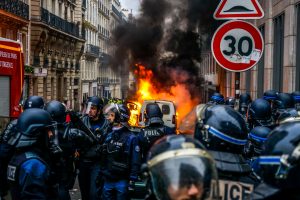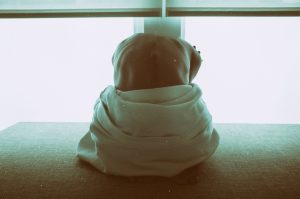I have treated first responders, families, communities, groups, and people of all ages for nearly 20 years involving the outcomes of Post Traumatic Stress Disorder (PTSD) and Acute Anxiety. Trauma is one of the most challenging and rewarding types of mental health treatment there is.
To understand our brain and trauma, one must first look at the biological issue that stems back to our very beginning. For example, let’s say you are a cave person and suddenly heard a loud running noise, saw the bushes being crushed, and then see a Saber-tooth tiger coming straight for you.
 After you have figured out a way to save yourself, think of what has happened to your brain. Everything about that event is now stored in the Limpic system, right above your brainstem instead of in the memory glands on the right and left bottom corners of your brain. The purpose is to allow your brain to access this information quickly in order to better survive the next time.
After you have figured out a way to save yourself, think of what has happened to your brain. Everything about that event is now stored in the Limpic system, right above your brainstem instead of in the memory glands on the right and left bottom corners of your brain. The purpose is to allow your brain to access this information quickly in order to better survive the next time.
So now every time bushes move, loud, running-type noises are heard, and you see something coming directly toward you, your brain goes on high alert and “fight or flight” kicks in.
In addition, we are always assessing our environment for those things instead of living our lives. Without treatment, the information stays in the Lympic system and as we experience life on a daily basis, we collect more trauma from unexpected events in life, which also builds on the symptoms until all you become is a walking trauma symptom (basically a brainstem with legs) — not to mention an adrenaline junkie as well. If you get that, then getting back to healthy is just a few steps away.
Acute Anxiety
Acute Anxiety happens in the first 30 days after the event (beyond becomes PTSD). If the symptoms go untreated, then they begin collecting more traumatic experience from either our memories or our environment.
Healing from Trauma
The best way to promote healing from trauma is to get as many traumatized parties who share a common event together and begin processing the feelings, thoughts, and memories together.
Each individual remembers things differently. Tunnel vision usually focuses each person on one of our sensory perceptions to survive. For instance, if the event happened in the dark, then smell or noise might be the sense we remember through.
 When people share their memories of the event, they all have different perceptions of how things happened and how fast. Also, many people forget traumatic events or sequences. By establishing a shared perspective immediately after an event, the event becomes safer and a support group has come to life. Guess what this does?
When people share their memories of the event, they all have different perceptions of how things happened and how fast. Also, many people forget traumatic events or sequences. By establishing a shared perspective immediately after an event, the event becomes safer and a support group has come to life. Guess what this does?
It creates an enormous opportunity for all in the group to re-evaluate their relationships with each other and with God. What this also does is makes the brain re-evaluate the memory collectively and pulls this information from the Limpic system back into the Memory glands, where it belongs. This basically drops a window between the person and the event. They remember the event, but no longer feel it from a fight or flight perspective.
When Acute Anxiety is not treated and the brain continues to view the world through trauma, more and more life experiences become traumatizing and we live in fear. That takes more energy than most of us can tolerate. Eventually, it will continuously blow into outbursts and isolation (if not escaping into alcohol or drugs).
Signs of PTSD
Post Traumatic Stress Disorder (PTSD) looks like this:
PTSD symptoms are generally grouped into four types: intrusive memories, avoidance, negative changes in thinking and mood, and changes in physical and emotional reactions. Symptoms can vary over time or vary from person to person.
Intrusive memories
Symptoms of intrusive memories may include:
- Recurrent, unwanted distressing memories of the traumatic event
- Reliving the traumatic event as if it were happening again (flashbacks)
- Upsetting dreams or nightmares about the traumatic event
- Severe emotional distress or physical reactions to something that reminds you of the traumatic event
Avoidance
Symptoms of avoidance may include:
- Trying to avoid thinking or talking about the traumatic event
- Avoiding places, activities or people that remind you of the traumatic event
Negative changes in thinking and mood
Symptoms of negative changes in thinking and mood may include:
- Negative thoughts about yourself, other people, or the world
- Hopelessness about the future
- Memory problems, including not remembering important aspects of the traumatic event
- Difficulty maintaining close relationships
- Feeling detached from family and friends
- Lack of interest in activities you once enjoyed
- Difficulty experiencing positive emotions
- Feeling emotionally numb
Changes in physical and emotional reactions
Symptoms of changes in physical and emotional reactions (also called arousal symptoms) may include:
- Being easily startled or frightened
- Always being on guard for danger
- Self-destructive behavior, such as drinking too much or driving too fast
- Trouble sleeping
- Trouble concentrating
- Irritability, angry outbursts, or aggressive behavior
- Overwhelming guilt or shame
For children 6 years old and younger, signs and symptoms may also include:
- Re-enacting the traumatic event or aspects of the traumatic event through play
- Frightening dreams that may or may not include aspects of the traumatic event
Treatment for PTSD
To treat PTSD, you have to be very insightful towards how your client is affected. It can take many modalities of treatment such as: Cognitive-Behavioral, Systematic Desensitization, and Eye Movement Desensitization Reprocessing (EMDR). What does all that mean?
 Well, Cognitive-Behavioral is generally talk therapy with directives. Systematic Desensitization deals with desensitizing your brain’s defenses around the trauma. Eye Movement Desensitization Reprocessing (EMDR) is moving through the memory from start to finish, like going through one train car of a train at a time. Using eye movement, tactile, or sound we are able to access the Limpic system and methodically move the memory of the event to the Memory Glands (like moving furniture around).
Well, Cognitive-Behavioral is generally talk therapy with directives. Systematic Desensitization deals with desensitizing your brain’s defenses around the trauma. Eye Movement Desensitization Reprocessing (EMDR) is moving through the memory from start to finish, like going through one train car of a train at a time. Using eye movement, tactile, or sound we are able to access the Limpic system and methodically move the memory of the event to the Memory Glands (like moving furniture around).
The real issue is the PTSD grows many roots by collecting trauma. Suddenly going into a crowd, being alone, driving by certain places, etc. becomes traumatic. You can no longer treat the traumatic event alone. Now you have to treat everything else that has become traumatic related to the event. If you miss one, the trauma usually comes back to some degree and continues to run a person’s life.
Not all trauma comes from events we directly experience. For instance, watching the twin towers fall on September 11, 2001 traumatized anyone who saw it happen directly or indirectly. Another traumatic event was when the people of Hawaii were told by text that North Korea launched nuclear weapons at Hawaii and they had 20 minutes to prepare.
 I have treated first responders for such events as 9/11, Las Vegas Shooting, Red Lake Indian Tribe school shooting, California fires, bank robberies, murders, sudden death, rape, and children drowning. As horrible as all of this is, through the Lord’s will, we have been been able to bring healing and renewal. No one is ever the same after trauma; we grow from the experience. We learn from each other and take that information to help other people heal.
I have treated first responders for such events as 9/11, Las Vegas Shooting, Red Lake Indian Tribe school shooting, California fires, bank robberies, murders, sudden death, rape, and children drowning. As horrible as all of this is, through the Lord’s will, we have been been able to bring healing and renewal. No one is ever the same after trauma; we grow from the experience. We learn from each other and take that information to help other people heal.
On December 25, 2000 (Christmas), I awoke to my father calling me to tell me that my mother and stepfather crashed their plane at Albuquerque airport. My mother died on the way to the hospital and my stepdad was in an induced coma.
CNN had reported it and identified them before notifying my two sisters and me. Both sisters were not able to go (one had a new baby and the other was out of the country), so I flew out with my brother-in-law to identify my mother and take her things from the plane. We also paid our last respects to my stepfather.
To say the least, this was one of the most traumatic days of my life. Not to mention, Christmas became a day of mourning. I share this because through the healing from the event, I began to understand death.
Instead of choosing to mourn my mother, I chose to celebrate her life. No one wants to be remembered for how they died. It is usually ugly, stinky, and undignified. We want to create as many memories in our lives so our lives move beyond us.
I chose to go places I would never go on my own in honor of her (all over the world). I chose to become a doctor (though I was already a therapist), in honor of her. She wanted me to do this since I was a child, and I didn’t. These events since her death have honored her life and amplified my life far beyond what I ever imagined. In addition, it geared me in the direction to better treat trauma and deal with horrible things immediately after they happen.
As an expert, one must step outside the events and give people a safe harbor to heal. I work directly and indirectly to move people through the healing process of trauma. It is only through God and the way He has shaped my life and ability that I can be of help through Him.
If you’re looking for help healing from trauma, I would be honored to walk with you on that journey.
“Touch the Sun,” courtesy of Marc Olivier Jodoin, unsplash.com, CC0 License; “Act IV,” courtesy of Norbu Gyachung, unsplash.com, CC0 License; “Pleading,” courtesy of Ben White, unsplash.com, CC0 License; “Healing,” courtesy of Larm Rmah, unsplash.com, CC0 License






